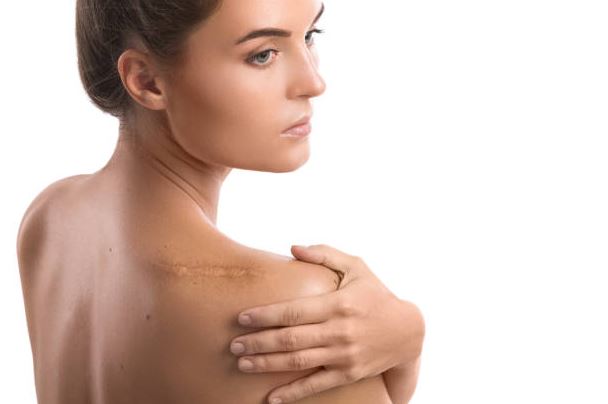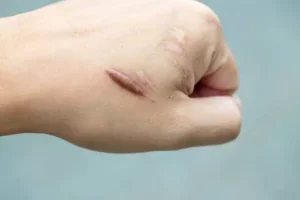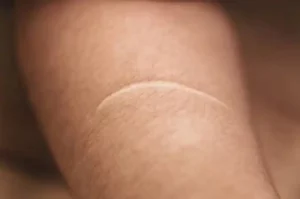What is a Keloid Scar?
Scarring is a natural part of the healing process following any kind of injury that breaks the skin. Scar tissue forms over the wound to help repair the skin and protect it from outside toxins as it heals. This is common and totally normal; however, in some cases, extra scar tissue forms over the wound that feels hard and looks raised. Those growths are known as keloids.
Keloid scarring is not very common. In fact, it only affects about 10% of people. Men and women are equally at risk for keloid scars, although people with darker skin do tend to experience them more often. Pregnancy is also a risk factor, as is age. People between the ages of 20 to 30 tend to get keloids more than older generations. Genetics play a large role in whether or not you will ever develop a keloid scar following an injury too. People of both Asian and Latino descent are more likely to experience keloid formation.
Symptoms of Keloid Scar Formation
There are certain symptoms that indicate you are going through what is keloid scar formation. The scar will look and feel abnormal and thicker than a regular scar. Many times it is smooth and shiny, with no hair growing on it, and looks bumpy and raised. You may also experience excess itchiness and some discomfort around the affected area. Your skin tone affects the color of the keloid. It may look red, brown or purple.
Keloids can occur following injuries to skin such as piercings, scratches, burns, surgical incisions, vaccinations or IV therapy insertions. Keloids have also been known to develop over scars from acne and chickenpox. If you are at risk for keloids or have a family history of keloids, you should try to avoid anything that may cause your body to scar, i.e., getting a tattoo or a body piercing.
Some of the most common places on the body to see keloid scars are on the ears, shoulders, cheeks and the middle of the chest. While keloids are not harmful, they are more of a cosmetic concern and can sometimes be very uncomfortable. Many people opt for treatment for keloid scar removal because they do not like the look of them; however, if you are prone to getting keloids, they can continue to come back for years to come, and in some cases, they can come back larger and worse than before. Sometimes, treatment is not even necessary as keloids can flatten and shrink on their own over time.
Treatment for Keloid Scars
While there are surgeries and laser treatment for keloid scars, there are also less invasive and more natural remedies that can work just as well without going through an actual procedure. Because keloids are often very firm and hard, one of the main ways to treat them is by keeping the skin moisturized and hydrated with different kinds of oils and lotions that are specifically suited for keloid scars. Vitamin E has been known to help with scarring, and some people suggest honey, coconut oil or apple cider vinegar as natural ways to decrease the appearance of keloids on the skin.
If you have a large keloid that is really making you feel uncomfortable or self conscious, natural remedies might not be effective enough for you. A Miami Vein doctor can surgically remove a keloid scar, but there is a risk for scarring to come back even after the surgery has been performed. Another surgical option that is less invasive is cryosurgery, which involves the use of cryotherapy to freeze off a keloid with liquid nitrogen. If you are very sensitive to the cold, this might not be the best option for you.
Laser Treatment for Keloid Scar Removal
Laser treatment is another option for keloid scar removal. This is the preferred method for scar removal at Fox Vein & Laser Experts. Our team uses the PicoWay laser for Miami scar removal. This type of treatment involves directing concentrated light energy at the sight of the scar. The beams of energy are short but very powerful; powerful enough to break through the structure of the skin causing the scarring and create new, healthier cells to help the scar blend into the skin and eventually fade away.
With laser treatment, however, there can be risks. There is a chance that scarring will still continue after the treatment. Before going through any kind of treatment for keloid, always talk with your healthcare provider about the potential risks.
Preventative Measures to Avoid Keloid Scarring
The most effective way to avoid keloid scarring is by adopting good preventative measures. Do your best to avoid injury to the skin. If you are not hurt, you can’t develop the keloids. If your skin is wounded, take every precaution to assist the healing process as much as you can. Keep the injury clean and covered so that outside bacteria cannot enter the opening in the skin. Keep the injury moist by applying healing ointments like Vaseline or Aquaphor.
Contact us at Fox Vein & Laser Experts
Fox Vein & Laser Experts is well versed at treating patients for all kinds of scars, including acne scars, contracture scars, hypertrophic scars, and keloid scars. If keloid scarring is bothering you, contact our office to schedule a consultation so we can determine the best treatment plan for you. Call 954-627-1045 to book your appointment.



